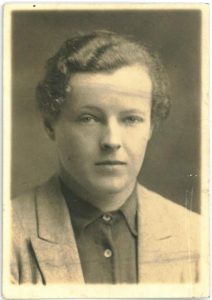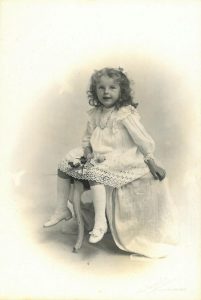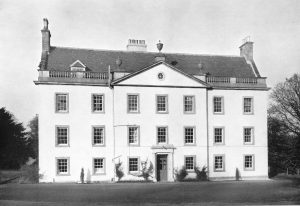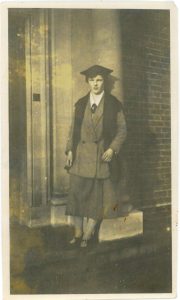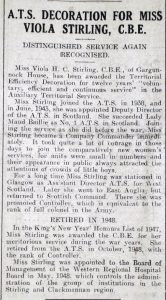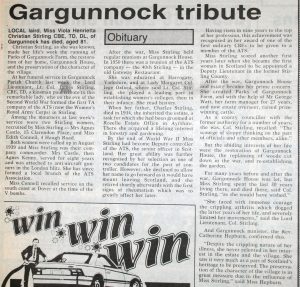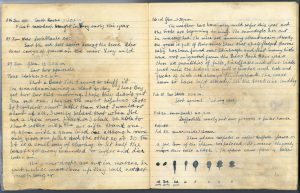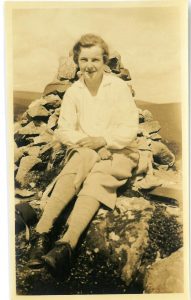Throughout 2017, we are going to be posting entries from the nature diary of Miss Viola Stirling of the Stirling family of Gargunnock. The Council Archives is fortunate to hold the Stirling family papers and this item is part of the collection. Each week we will be posting two entries from the diary.
Miss Viola Stirling of Gargunnock house was a remarkable woman in many ways. She was a pioneer at University in Oxford, being involved in the setting up of women’s colleges there, which was only just beginning when she arrived, and by organising the first women’s inter varsity boat race. She formed the first women’s Territorial Army company of the Auxiliary Territorial Service in Stirling after she joined the service in 1938 and was honoured for her military work during the Second World War. She was a Stirling County Councillor for ten years and was the first woman appointed Deputy Lieutenant of a county in Scotland. However, she is best remembered for single-handedly running the Gargunnock estate for over 55 years and through her influence, shaping the village of Gargunnock and the surrounding countryside. Her love of and devotion to this local landscape is clear in this remarkable journal, begun when she was just 12 years old.
Viola Stirling – a biography
Miss Stirling was born on 3rd June 1907 at Windsor, Berkshire and was the only child of Charles Stirling and Evelyn Mary, nee Saffery. She was christened Viola Henrietta Christian Stirling but as a young child was known by the family nickname ‘The Trout’. Although she was born in England, Miss Stirling spent much of her childhood on the Gargunnock estate and its environs. She was educated at a girl’s boarding school in Harrogate, which occasionally receives a short mention in the notebook. Her holidays were spent on the estate and it is clear that she spent much of her time observing the wildlife around her and took a keen interest in insects, animals and birds and their lifecycles.
University life was spent at Lady Margaret College, Oxford where Miss Stirling read history. She was influential here, helping with the movement to establish women’s colleges, which at this time were in their infancy and organising the first women’s Boat Race. After this, she worked for a number of years in the Estate Office at Rozelle in Ayrshire, an estate owned by her Hamilton cousin, where she gained valuable experience in land management. Miss Stirling’s father, Charles, took the decision to put the Gargunnock Estate up for sale in 1933 owing to some financial difficulties. This was not to be, however, as his daughter was determined to keep the property she loved in the family, and after his death in the following year, she removed it from the market and began administering it herself.
Under her management, the estate prospered. She created Parks of Gargunnock Farm and with the assistance of her Estate Manager George Watt, raised prize-winning cattle.
Viola Stirling joined the Auxiliary Territorial Service (now the Women’s Royal Army Corps) in 1938 at the rank of Company Commander and formed the first women’s Territorial Army company in Stirling. She excelled in the forces and quickly rose to the rank of Deputy Controller, the highest office in Scotland. She was offered the office of Controller for the whole of the UK, but as this would have meant living in London, she refused the post, choosing to remain in Scotland. In the New Year’s Honours list for 1947, Viola Stirling was awarded the CBE for her meritorious service during the war years, one of the first military honours given to a member of the ATS. She retired from the ATS in 1948 and returned to her beloved Gargunnock Estate.
During the war years, the Estate was let to various tenants including a girls’ school, and when Miss Stirling returned to Gargunnock House there was still a tenant living there so initially she moved in to a flat over the stables. Once in residence, she set about restoring the parks and gardens at Gargunnock House beginning a programme of new planting in the gardens and woods and renovation of the house, which she moved back into in the late 1950s. Her influence spread beyond the Estate: she took a keen interest in local history, undertaking research into the original feus of the village and tracing back the occupants of the various properties within it. It is to her influence on local planning decisions through the years that we owe the attractive nature and shape of Gargunnock today.
Miss Stirling entered into public life with some gusto, acting as a Councillor for Stirling County Council for 10 years and being appointed the first woman Deputy Lieutenant of a County when she took up that office for the County of Stirlingshire.
Towards the end of her life, keen to ensure that her legacy would endure, she set up the Gargunnock Charitable Trust to be administered by Sir James Stirling of Garden who continues to run the estate on behalf of the Trust to this day.
Miss Stirling remained a respected figure in the local community up until her death at the age of 81 in the spring of 1989.
The Notebook
The nature notes are in a soft backed jotter and date from between August 1919, when the author was 12, to April 1928, when she was 20, although there are some lengthy gaps. It was deposited with the Council Archives as part of the wonderful collection of papers of the Stirling family of Gargunnock and is just one of the remarkable items in that archive. The volume has been allowed to get damp at some point and is fragile, showing some staining on its pages.
It is clear that Miss Stirling took the jotter with her on her travels between home, school and holiday destinations as there are entries from all of these locations. Most of the observations are made from her walks around the Gargunnock estate however, and reflect her interests in wildlife and hunting. Miss Stirling had a keen eye, and a very real sense of her love for her environment and of a sharp sense of humour are evident in these pages.
Early on in the volume, Miss Stirling appears to give her own names to places on the estate after the wildlife that she sees there. Her developing interest in hunting is evident from the entries made when she was in her mid teens. Although she clearly likes shooting and enjoys experiments in taxidermy, her appreciation of and respect for wild things is very obvious from the way in which she expresses her thoughts throughout this diary. It is easy to see from the sensibility of the child how she became the kind of engaged and thoughtful woman that she turned out to be.
Our thanks go to Sir James Stirling and his family and to the Gargunnock Charitable Trust for their kind permission to reproduce this item in our blog.
Copyright over all records from the Stirling of Gargunnock family papers collection remains with the Trustees of the Gargunnock Estate Trust. These images may not be reproduced without the permission of the Trustees.
We will begin to post entries from the diaries very soon.
